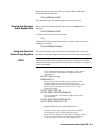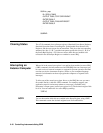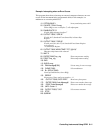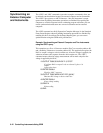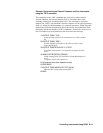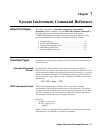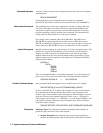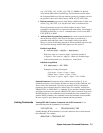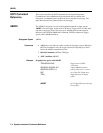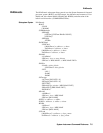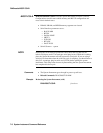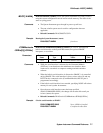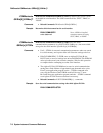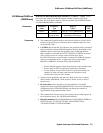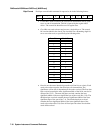(e.g., 123, 123E2, -123, -1.23E2, .123, 1.23E-2, 1.23000E- 01). Special
cases include MIN, MAX, and INFinity. The Comments section within
the Command Reference will state whether a numeric parameter can also
be specified in hex, octal, and/or binary. # H7B, # Q173, # B1111011
• Boolean parameters represent a single binary condition that is either true
or false (e.g., ON, OFF, 1, 0). Any non-zero value is considered true.
Discreet parameters select from a finite number of values. These
parameters use mnemonics to represent each valid setting. An example is
the TRIGger:SOURce < source> command where source can be BUS,
EXT, HOLD, or IMM.
• Arbitraty Block Program Data parameters are used to transfer blocks of
data in the form of bytes. The block of data bytes is preceded by a
preamble which indicates either 1) the number of data bytes which
follow, or 2) that the following data block will be terminated upon receipt
of a New Line message with the EOI signal true. The syntax is:
Definite Length Block
# < non-zero digit> < digit(s)> < data byte(s)>
Where the value of < non-zero digit> equals the number of
< digit(s)> . The value of < digit(s)> taken as a decimal integer
indicates the number of < data byte(s)> in the block.
Indefinite Length Block
# 0< data byte(s)> < NL^ END>
Examples of sending 4 data bytes:
#14<byte><byte><byte><byte>
# 3004< byte> < byte> < byte> < byte>
#0<byte><byte><byte><byte><NL^END>
Optional Parameters. Parameters shown within square brackets ([ ]) are
optional parameters. (Note that the brackets are not part of the command, and
are not sent to the instrument.) If you do not specify a value for an optional
parameter, the instrument chooses a default value. For example, consider the
ARM:COUNt? [< MIN| MAX> ] command. If you send the command without
specifying a parameter, the present ARM:COUNt value is returned. If you send
the MIN parameter, the command returns the minimum count available. If you
send the MAX parameter, the command returns the maximum count available.
Be sure to place a space between the command and the parameter.
Linking Commands Linking IEEE 488.2 Common Commands with SCPI Commands. Use a
semicolon between the commands. For example:
* RST;OUTP ON or TRIG:SOUR HOLD;*TRG
Linking Multiple SCPI commands. Use both a semicolon and a colon between
the commands. For example:
ARM:COUN 1;:TRIG:SOUR EXT
System Instrument Command Reference 7-3



